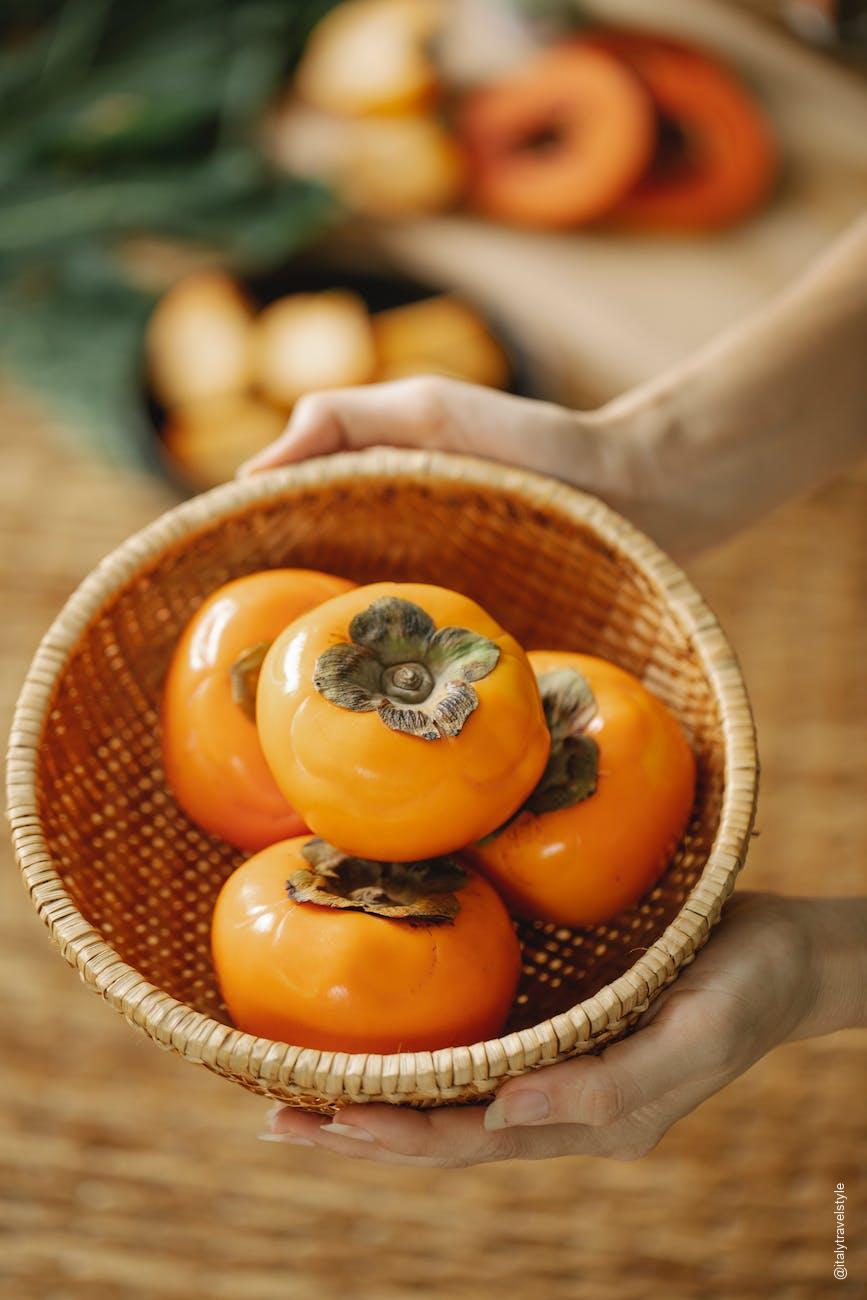If you have been following us, you’ll know that we love the late autumn and winter fruit persimmons! Known as cachi in Italy, this is one of those foods that you either love or hate. Join us as we delve into the wealth of nutrients and therapeutic properties concealed within the vibrant hues of this remarkable fruit.
In this article:
What are persimmons?
At the crossroads of taste and nutrition lies the humble persimmon, a fruit treasured for centuries not only for its delightful flavor but also for its remarkable health benefits. Persimmons can be red or orange and look like tomatoes. Cachi that are round are sweet, cachi that are long and oval are bitter. A ripe persimmon is full and feels like a small water balloon.
Pear, persimmon and almond jam made by the Friars of Carmelitani Scalzi di Loano,
230 g jar (package of 6 pieces)
€35 Buy on Amazon
Fruit jam made by the Friars of Carmelitani Scalzi di Loano in the Carmelo Convent. The convent is an oasis of peace, where dedication and nature come together to create tasty delicacies Made with persimmons, pears, almonds, sugar and fruit pectin. Contents of the single jar: 230 grams. See more products made by the Friars of Carmelitani Scalzi di Loano.
How do you say persimmon in Italian?
In Italian, persimmons are Cachi, pronounced KA-ki. The singular is caco, pronounced Ka-co.
The persimmon tree, which bears fruit that ripens into mature, edible fruit in the fall, is said to have been brought from Asia to Italy in the late 1800s. The tree’s small, beautiful white flowers bloom in late spring, and the fruit in late autumn.
How do you eat a persimmon?
Persimmons look like tomatoes but are sweet and mushy inside. It best to eat them with a spoon. We’ve made a video to show you how we do it.
Nutritional benefits of persimmons
Persimmons boast a cornucopia of essential nutrients packed within their petite frames. A mere 168-gram persimmon offers a plethora of vital elements, including:
- Calories: 118
- Carbohydrates: 31 grams
- Protein: 1 gram
- Fat: 0.3 grams
- Fiber: 6 grams
- Vitamin A: 15% of the Daily Value (DV)
- Vitamin C: 14% of the DV
- Vitamin E: 8% of the DV
- Vitamin K: 4% of the DV
- Vitamin B6 (Pyridoxine): 10% of the DV
- Potassium: 6% of the DV
- Copper: 21% of the DV
- Manganese: 26% of the DV
- Source
Antioxidant Powerhouse
Persimmons emerge as stalwarts in the realm of antioxidants, harboring a treasure trove of plant compounds like tannins, flavonoids, and carotenoids. These potent antioxidants play a pivotal role in mitigating oxidative stress, a process implicated in various chronic ailments ranging from heart disease to neurological disorders like Alzheimer’s.
Heart Health Champion
Heart disease, the silent assailant of our times, faces formidable opposition from the nutritional arsenal of persimmons. Laden with flavonoid antioxidants such as quercetin and kaempferol, persimmons wield the power to curb blood pressure, slash LDL cholesterol levels, and quell inflammation, thereby fortifying the fortress of cardiovascular well-being.
Inflammation Alleviator
In the relentless battle against inflammation, persimmons stand as staunch allies. Rich in vitamin C, carotenoids, flavonoids, and vitamin E, these fruits orchestrate a symphony of anti-inflammatory actions, offering respite from the ravages of chronic inflammatory conditions.
Cholesterol Champion
The scourge of elevated cholesterol levels finds a formidable adversary in the soluble fiber-packed persona of persimmons. Studies indicate that the consumption of persimmon fiber leads to significant reductions in LDL cholesterol levels, thus heralding a new dawn in the fight against cardiovascular disease.
Guardians of Vision
With their bounty of vitamin A, lutein, and zeaxanthin, persimmons assume the mantle of protectors of ocular health. These nutrients, found in abundance within persimmons, fortify the eyes against age-related macular degeneration and bolster the defenses against vision impairment.
Recipe ideas for persimmons
– Salad Sensations
Infuse your salads with a burst of flavor by creating a dressing with persimmons, balsamic vinegar, and oil.
– Breakfast Bliss
Elevate your morning yogurt or oatmeal to new heights of deliciousness with the addition of fresh or cooked persimmons. Heat persimmons on low heat and eat warm, not hot.
– Dessert Delights
Indulge your sweet tooth guilt-free by roasting persimmons in the oven and drizzling them with honey for a tantalizing treat.
– Baking Bonanza
Transform your baked goods into culinary masterpieces by mixing dried or fresh persimmons into muffin, bread, or cake recipes.
– Savory Splendor
Embark on a gastronomic adventure by pairing persimmons with savory delights such as chicken or baked Brie for an unforgettable culinary experience. Instead of using oranges for duck or chicken, use persimmons.
In conclusion, the persimmon emerges not only as a tantalizing treat for the taste buds but also as a nutritional powerhouse teeming with health-enhancing properties. With its ability to bolster heart health, combat inflammation, regulate cholesterol levels, and safeguard vision, the persimmon rightfully earns its status as a superfruit worthy of a prominent place in your diet. So, embark on a journey of culinary exploration and savor the myriad delights that persimmons have to offer. Your taste buds and your health will thank you.
Discover more from Italy, Travel & Style
Subscribe to get the latest posts to your email.







You must be logged in to post a comment.